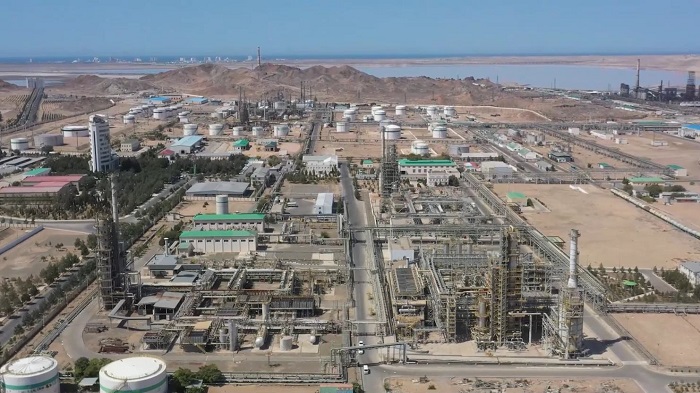Ms. Sona Kerimova, the Chief Specialist of the Oil Refining Department of the State Concern Turkmennebit of Turkmenistan gave a presentation at the TESC 2024 in Ashgabat recently.
The title of her presentation was: Emissions Reduction of Greenhouse Gases – Strategy of State Concern Turkmennebit of Turkmenistan.
We are presenting here a reformatted and slightly abridged version of her presentation:
SC “Turkmennebit” carries out exploration and development of oil and gas fields, production and transportation of oil, gas, gas condensate, oil treatment and refining, with subsequent sale of oil products in the domestic market and export abroad..
Turkmenistan has huge reserves of natural gas and crude oil. The oil and gas industry is the main source of methane emissions in Turkmenistan.
Volume of GHG emissions in Turkmenistan:
– energy sector – more than 85%,
– agriculture – 12.4%,
– industrial processes – 1.9%
– other sources – 0.6%
TURKMENISTAN’S REPORTING ON GREENHOUSE GAS EMISSIONS
1998 – First national inventory of GHG emissions in Turkmenistan.
2016 – Turkmenistan submitted its first Nationally Determined Contribution (NDC) under the Paris Agreement on Climate Change to the Secretariat of the United Nations Framework Convention on Climate Change (UNFCCC)
2022 – Latest update of the NDC of Turkmenistan
Turkmenistan recently approved a Roadmap for the development of international cooperation following Turkmenistan’s accession to the Global Methane Commitment.
Main measures proposed by Turkmenistan to reduce GHG emissions in the oil and gas sector:
1. Improvement of methods for monitoring pollutant emissions.
2. Use of automatic systems to detect methane leaks.
3. Reduction of leaks from main oil and gas pipelines.
4. Reduction of leakages from low and medium pressure natural gas distribution networks.
5. Ensuring timely repair and replacement of equipment used on in-field and trunk oil and gas pipelines.
6. Modernization of flare equipment, introduction of new devices and technologies for associated gas utilization at fields
7. Improvement of the oil and gas transportation and consumption accounting system.
8. Construction of mini-compressor stations at low-producing fields.
Searching for practical opportunities
– associated gas utilization
– conservation by supplying natural gas to the system
– reinjection into the reservoir to maintain pressure.
State Concern “Turkmennebit”
Currently, SC “Turkmennebit” has achieved that almost the entire volume of produced associated petroleum gas is used for gas-lift method of oil production.
Based on the introduction of innovative and energy-efficient technologies and renovation of existing infrastructure, it is planned to significantly reduce methane emissions.
Currently, the refineries of Turkmennebit have established partnerships with world-famous companies, which has allowed the introduction of new technologies in the development of plants, including
“UOP A Honeywell Company”
“Axens IFP Group Technologies”
“BASELL POLYOLEFINS”
“DuPont-STRATCO®”,
“Chiyoda”,
“ТЕCHNIP”,
“JGC Corporation”,
“LG International Corp.”,
“Hyundai Engineering Co., LTD.” and – other world-renowned companies
Process gases generated in the refinery units are directed to specially designed furnaces. This is where methane combustion takes place. If there is not enough oxygen during combustion, i.e. less than necessary for complete combustion, soot and carbon monoxide CO will be formed. For this purpose, the furnaces are equipped with oxygen analyzers. The resulting water is used for the plant’s own needs.
Refineries do not currently discharge methane in its pure form into the atmosphere.
If the methane is not burned, it will be released into the atmosphere in its pure form, and it will be invisible or appear as vapor.
Methane is 25 times more harmful to the environment than carbon dioxide when it comes to warming the planet over a 100-year period.
Separation and utilization units of the Turkmenbashi Refinery flare facility
Separation and utilization units of the Turkmenbashi Refinery flare facility are designed for separation and utilization of hydrocarbon gases and vapors discharged by process units and facilities.
Utilization of flare gas reduces the amount of flared discharges and thus is one of the environmental protection measures that reduce the negative impact on the environment.
ISO Certification
Turkmenbashi Refinery Complex has international certificates
ISO 9001:2015 — QUALITY MANAGEMENT SYSTEMS
ISO 14001: 2015 — ECOLOGICAL MANAGEMENT
This confirms that the ecological management system is effectively applied at TCOR. /// nCa, 11 June 2024
